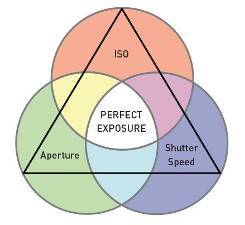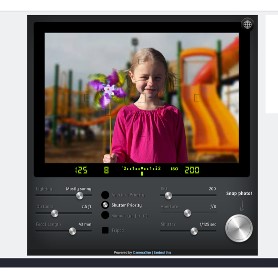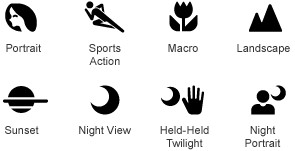- Home
- 21st Century Skills - Technology
- Content-based Instruction: Application of Knowledge of Manual Camera Settings
Content-based Instruction: Application of Knowledge of Manual Camera Settings
Ed Topliffe is an assistant professor at Hanyang University, Seoul campus. He teaches the course Introduction to Digital Photography, which is a language-based elective class offered to both Korean and international students.
In the 21st century in the field of ESL there has been an emergence of educational focus in areas such as Content-based Instruction (CBI). Such courses enable students to learn actual content as they would in regular courses taught in their native language. As the majority of the students at Hanyang University have intermediate to advanced levels of English, they are able to successfully complete CBI courses, and because of government funding, there is an increasing number of these courses that they can choose from.
Introduction to Digital Photography is a CBI course which has three main points of focus: manual settings of cameras, lighting, and composition of photographs. Of these three, students have the most difficulty with manual camera settings as this involves understanding technical concepts and involves unfamiliar terminology. Nevertheless, being able to use manual settings effectively is an important skill as it allows the user to have more control of his or her ability to take photographs compared to what the camera can determine in automatic mode. This can also lead to an overall increase in confidence and interest in picture taking.
Over the past 10 years with the development of smartphone camera technology, picture taking has increased dramatically. Smartphone cameras are now using computational photography where the phone will take several photographs and through the use of software determine optimal lighting and focal points and produce the best result possible. Phone models such as Hwawei Mate 30 Pro, Samsung Galaxy 10, and iPhone 11 offer impressive photo results. However, these cameras still have limitations because of small lens and sensor sizes compared to mirrorless and DSLR cameras. In Introduction to Digital Photography students are able to understand these limits and possibly work around them. For those students in the class who own mirrorless or DSLR cameras, they can also learn how to get the most out of their devices.
In order for students to feel confident with manual camera settings they need to have a clear understanding of the relationship between the camera’s shutter speed, ISO, and lens aperture. This can best be explained using a visual diagram called the Exposure Triangle (see below).

Retrieved from http://timberwolfphotolounge.blogspot.com/2016/10/exposure-triangle-aperture-shutter-iso.html
According to the diagram, when the shutter speed, aperture, and ISO are set properly in relation to each other, the proper amount of light will be recorded on the camera’s sensor resulting in ‘perfect exposure.’ If there was a change to 1 of the 3 areas, then 1 or both of the other areas would also have to change in order to compensate. For example, if the aperture became larger, more light would come in through the lens, and to compensate, the shutter speed could increase, or the sensor could become less sensitive to light through a lower ISO.
A very effective way to help students fully understand the relationships with the Exposure Triangle is to have them experiment on their own cameras and report their experiences. However, since the majority of the students in the class do not have access to cameras other than their smartphones, they are given an assignment using a website which acts as a camera simulator (http://camerasim.com/apps/original-camerasim/web//).

Retrieved from https://camerasim.com/camerasim-free-web-app/
In this activity students are given 5 sets of camera settings (5 photos). After they adjust the settings in the camera simulator they take the photo and then describe the results in terms of exposure and clarity/blurriness. They then explain the reason for the results using the relationships within the Exposure Triangle.
In the following class, in which the students have submitted their assignment, one additional activity is conducted which builds on what was covered. This involves camera scene modes, which many mirrorless and DSLR cameras offer (see diagram below).

Retrieved from http://www.jemome.com/p-camera-mode-icons-379631/
Students are put into pairs and asked to discuss the purpose of each scene mode and determine how the camera will select the settings. The students are now going beyond the level of merely understanding the material and actually applying their knowledge in a new situation. Student feedback upon completing this activity has been very positive.
Even though this article focuses on the learning of content, the activities discussed are equally as beneficial in terms of language development. 21st century technology such as the camera simulator website can be used to generate results that students can then be responsible for explaining to their classmates. Students can focus on terminology involving aperture, shutter speed, and ISO and can go even further by explaining details such as f-stop numbers and shutter speed in terms of fractions such as 1/2000th of a second. In fact, this is what students do in the course for their presentation assignment where they present three photos to the class and describe the background behind taking the photo, the results in terms of lighting and composition, and the technical details involving aperture, etc.
To conclude, the ability to operate manual camera settings can be very beneficial in photography but requires effective instruction. Having students do a hands-on activity using a camera simulator helps them to fully understand the relationships within the Exposure Triangle. Students are then able to apply their knowledge in different situations such as determining camera scene mode settings and real-life camera usage. Lastly, photograph-related activities such as the ones discussed do not have to be limited to CBI classrooms. Instructors who are focused on language development can easily take advantage of the numerous opportunities the activities have to offer.
Please check the Practical uses of Technology in the English Classroom course at Pilgrims website.
Content-based Instruction: Application of Knowledge of Manual Camera Settings
Ed Topliffe, South KoreaAn Aggregated Automated Anonymized Assignment Collection (A4C) System for Translation Classes
Daniel Svoboda, South KoreaUsing Online Collaborative Writing to Illustrate Research Skills
Richard Prasad, South Korea